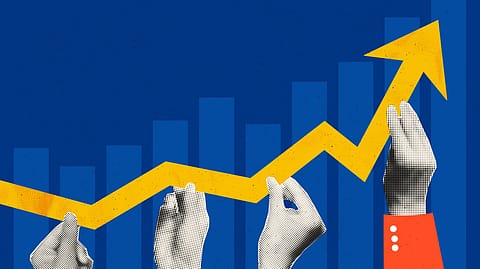GST 2.0 powers India’s growth revival as inflation hits record low: RBI
The Indian economy is showing signs of recovery, bolstered by GST 2.0 reforms and robust festive spending. The RBI reports strong growth in the manufacturing and services sectors in October 2025, with vehicle sales at record highs.

The Indian economy showed signs of a further pick-up in momentum, despite lingering external sector headwinds, thanks to the Goods and Services Tax (GST) reforms initiated by the government, which helped improve demand conditions across urban and rural areas. High-frequency indicators of overall economic activity remained robust in October 2025, supported by GST rate cuts and a pick-up in festive spending. As a result of GST 2.0 reforms, GST revenue improved, albeit at a slower pace than the previous month, indicating a strong pick-up in consumer demand.
“Sowing of all rabi crops is progressing well following the harvesting of kharif crops. High-frequency indicators for October suggest further broadening of manufacturing activity and continued robust expansion in the services sector,” the RBI said in its Bulletin for November 2025.
The high-frequency indicators of overall economic activity remained robust in October 2025, supported by GST rate reductions and a pickup in festive spending, the RBI data shows.
Among high-frequency indicators, digital payments registered a moderation in growth, in both volume and value, during October 2025. Recent data on digital transactions also indicate a rising adoption and usage of digital payments across regions and merchant categories, including groceries and supermarkets, and gold purchases.
During October, the RBI says the overall demand conditions showed signs of improvement, which showed in increased festive spending and a sharp pick-up in 2-wheeler and automobile sales. “Rural demand steered overall demand, supported by favourable monsoon conditions, strong agricultural activity, GST rate reductions, and increased festive season spending. Rural demand for two-wheelers and automobiles registered a sharp pickup, as sales recorded the highest growth rate for both series. Urban demand also gained momentum, with passenger vehicle sales recording their highest growth in the past nine months. Vehicle registrations recorded strong growth across all major segments compared with the corresponding festive period last year, reflecting strong consumer sentiment and the positive impact of GST rate cuts.”
The available high-frequency indicators point to sustained strength in manufacturing activity. The manufacturing Purchasing Managers’ Index (PMI) accelerated during the month, supported by a sharp expansion in output and new orders, underpinned by resilient domestic demand and the continued positive effects of GST reforms. “Steel output grew strongly, reflecting continued momentum in infrastructure and construction activity. Automobile production showed mixed signals as the passenger vehicle segment and three-wheelers recorded robust growth while production of two-wheelers declined.”
India’s services sector also demonstrated sustained expansionary momentum, supported by robust festive demand and GST relief. However, unseasonal rains led to some sequential softening in activity in October. “Sales of retail commercial vehicles rose to a near three-year high. Growth in port traffic accelerated, led by an uptick in petroleum, oil & lubricants and containerised cargo. Growth in cement production improved, while steel consumption moderated,” says the RBI report.
Recommended Stories
The headline CPI inflation declined in October to touch an all-time low in the current series. Headline CPI inflation moderated to 0.3 per cent in October 2025 from 1.4 per cent in September. The fall in inflation was driven by the deepening of deflation in food prices and the impact of the GST rate cut on goods and services prices, amid large favourable base effects.
The central bank says improved macro frameworks and outcomes have not only enhanced the ability of financial institutions to support the macroeconomy but also allowed the Reserve Bank to calibrate regulatory measures better, to improve the efficiency of financial intermediation and augment the flow of credit to the broader economy.
It said the “fiscal, monetary, and regulatory measures undertaken so far this year should pave the way for a virtuous cycle of higher private investment, productivity, and growth”, leading to long-term economic resilience.